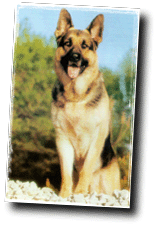
If any breed of dog is most deserving of
the title Noble with Natural Beauty then that dog is the German
Shepherd.
He is a dog with elegant yet flowing
lines, glamorous to behold, with a shining coat, erect ears, and an
intelligent expression that will command attention wherever he is seen.
His eyes indicate the love and affection he has for those who care for
him and his sweeping tail will show his mood whether it be gay or sad.
By nature a German Shepherd is wary of
strangers, though once one is accepted by him he is a friend for life.
He is an efficient obedience worker, quick to learn and what is learned
will never be forgotten. It is an active breed and thrives on
work—little is beyond its capabilities. Fleet of foot, powerful yet
graceful and nimble, he is the epitome of those qualities considered to
be ideal within a dog.
He loves human companionship and will
respond to his owner’s mood whether this be lying quietly by his side or
romping across the fields; indeed, at all times, his one desire is to be
with you and to please you.
He has a keen sense of humor and enjoys playful games yet, in defense of those he loves, can become a frightening adversary that one would be well advised to keep clear of. He can fit into a flat or a mansion as the need may be, for he is happy wherever you are happy.
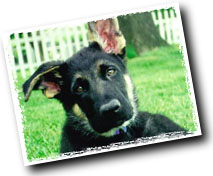 In
bringing a German Shepherd into your home, you are making an addition to
your family and he will quickly feel a part of it. Your house, your
garden, your possessions and in fact all that you own will from then on
be in his special care. He needs your love, but he needs also correct
attention to his grooming, exercise, food, and general welfare. Given
these, your German Shepherd will devote his very life to you and you
will be the richer for this and for the companionship and love you both
will share.
In
bringing a German Shepherd into your home, you are making an addition to
your family and he will quickly feel a part of it. Your house, your
garden, your possessions and in fact all that you own will from then on
be in his special care. He needs your love, but he needs also correct
attention to his grooming, exercise, food, and general welfare. Given
these, your German Shepherd will devote his very life to you and you
will be the richer for this and for the companionship and love you both
will share.
In a short work such as this, one cannot
look too deeply into the history of the breed for this would take up a
volume in itself. However, it is important that all Shepherd owners have
an insight, brief though it may be, into the development of the breed
for it is this development that has given us the German Shepherd we see
today. Only a few early dogs and only one person is named in this
history, though it will readily be appreciated that there were many dogs
and many people whose efforts and sacrifices have furthered the growth
of the German Shepherd.
Almost from the very dawn of mankind the
dog has figured prominently. Early man quickly recognized the dog’s
ability to complement those faculties in which he was weak. The dog
could run better, see better, hear better and had a far more acute sense
of smell than man.
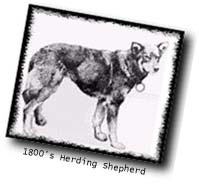 Wild
dogs were captured and reared within man’s encampment, and in return for
food, shelter, and protection, would help man hunt and give him advance
warning of predatory animals. This was the beginning, and as man settled
from his nomadic wanderings his requirements of the dog changed. He now
needed more diversity in his dogs. There were those for hunting, those
for protecting his home and family when he was away, those for carrying
small burdens, and those for helping tend his flocks and cattle. The
dawn of the pastoral shepherd dog had arrived. Throughout the world slow
development was taking place, but the pace quickened in Europe where man
himself was raising his standards more rapidly.
Wild
dogs were captured and reared within man’s encampment, and in return for
food, shelter, and protection, would help man hunt and give him advance
warning of predatory animals. This was the beginning, and as man settled
from his nomadic wanderings his requirements of the dog changed. He now
needed more diversity in his dogs. There were those for hunting, those
for protecting his home and family when he was away, those for carrying
small burdens, and those for helping tend his flocks and cattle. The
dawn of the pastoral shepherd dog had arrived. Throughout the world slow
development was taking place, but the pace quickened in Europe where man
himself was raising his standards more rapidly.
The size, coat, and color of sheepdogs at
this time varied greatly, dependent upon many factors. The weather
clearly dictated that dogs working in cold areas would have profuse
coats while those of temperate climates would have shorter coats. Areas
where predatory animals were found in large numbers would need more
powerful dogs than those lands dominated by man. The wolf, the bear, the
large birds of prey—all would influence man’s choice of sheepdog.
In Germany, as in France, the United Kingdom, Holland, and others, the growth of large industrialized cities meant that predators were declining quickly and also that there was a greater awareness of the excellence of the shepherding dogs of different areas. The establishment of dogs of fixed type was now at hand although there were still great variations to be found from one area to another. Breeders would meet and discuss the relative merits and shortcomings of certain dogs, and it followed that dogs of high merit were much in demand as breeders tried to fix into their stock the sterling qualities seen in dogs from other areas. It came to pass that in Germany, in 1891, a group of enthusiasts formed the Phylax Society with the aim of fostering and standardizing native German breeds. The society was short-lived and in 1894 it was disbanded, but it had sown the seeds from which the German Shepherd was to emerge.
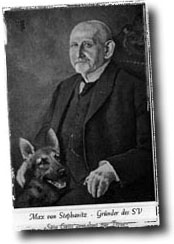 At
this time Capt. Max von Stephanitz appears in the breed’s history and
indeed it is this man who is acclaimed as the father of the breed. Von
Stephanitz had long admired the qualities of intelligence, strength, and
ability found in many native sheepdog breeds but had yet to see one
which embodied all of his ideals. Chance was to play its part, and
while visiting a show with a friend in 1899, he saw a dog that impressed
him greatly to all accounts so much that then and there he purchased the
dog and promptly formed a society, the Verein fur deutsche Schaferhunde
or SV as it is called. This was a milestone in the breed’s history and
marked the beginning of a new era for it. From this date the German
Shepherd as a specific breed had arrived.
At
this time Capt. Max von Stephanitz appears in the breed’s history and
indeed it is this man who is acclaimed as the father of the breed. Von
Stephanitz had long admired the qualities of intelligence, strength, and
ability found in many native sheepdog breeds but had yet to see one
which embodied all of his ideals. Chance was to play its part, and
while visiting a show with a friend in 1899, he saw a dog that impressed
him greatly to all accounts so much that then and there he purchased the
dog and promptly formed a society, the Verein fur deutsche Schaferhunde
or SV as it is called. This was a milestone in the breed’s history and
marked the beginning of a new era for it. From this date the German
Shepherd as a specific breed had arrived.
The dog was called Hektor Linksrhein but
was later named Horand v Grafeth by Von Stephanitz, who used the animal
as the basis on which much future development would be made. Horand was
greatly admired by many breeders who were quick to use him in their
breeding programs. Not surprisingly, he became the dog that best
exemplified the goals of early breeders.
Horand’s most celebrated son was Hektor v
Shwaben, who in turn sired Heinz v Starkenburg and the litter brothers
Beowolf and Pilot.
Each of these dogs in turn sired many progeny and became pillars in the development of the German Shepherd. Von Stephanitz was a cavalry captain and was ideally suited to impose his strong will over the SV of which he was president. In this capacity and with uncompromising dedication he directed the breeding programs. The dogs of Thuringia, Frankonia, and Wurttemburg were all used, each area providing dogs which had special merits of tail and ear carriage, size, color, and temperament.
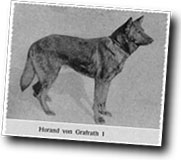 The
degree of inbreeding was necessarily high at this time, for although it
carried risks of incorporating faults, it likewise enabled the breeders
to fix permanently those qualities which today are such features of the
breed. Von Stephanitz believed above all else that the German Shepherd
should be bred for utility and intelligence and this was to become his
motto. It was this adaptability that was later to make the dog the
world’s greatest all-rounder.
The
degree of inbreeding was necessarily high at this time, for although it
carried risks of incorporating faults, it likewise enabled the breeders
to fix permanently those qualities which today are such features of the
breed. Von Stephanitz believed above all else that the German Shepherd
should be bred for utility and intelligence and this was to become his
motto. It was this adaptability that was later to make the dog the
world’s greatest all-rounder.
With the oncoming of the twentieth century, and having seen the SV develop into the largest single breed club in the world, Von Stephanitz was turning his attention to the long-term future. He was able to foresee that in a growing industrialized nation the role of the pastoral shepherd dog would decline and the breed must be able to adapt to other work if it were to continue as a functional animal.
It seemed that the very qualities that
made the German Shepherd such an exceptional sheepdog could well be put
to good use by government departments. This was the thinking of Von
Stephanitz and this was to be his next campaign. As always, he achieved
this and during World War I was seen as messenger dog, rescue dog,
sentry dog, and personal guard dog. Servicemen from the USA, UK, and the
Commonwealth would see first hand the dog’s bravery, intelligence, and
steadfastness, and many stories were taken back home. Not surprisingly,
a number of dogs were acquired by servicemen and transported home with
them.
In 1919, when the English Kennel Club gave the breed a separate register, some 54 animals were included, but by 1926 the ranks had swelled to 8,058, such was the unprecedented success of the dog. At the end of the War it was thought that the breed would not flourish were the word German to appear in its name and it was therefore decided to call the breed the Alsatian Wolf Dog after the German-French border area of Alsace-Lorraine. The “Wolf Dog” tag was later to be dropped—again as it was felt that this would prejudice the breed. Thus we had for many years the misnomer of the breed brought about by national hostilities. In 1977, following numerous campaigns by breeders the name of the breed was changed back to the German Shepherd Dog by which it is known in the USA, Australia, and most other countries.
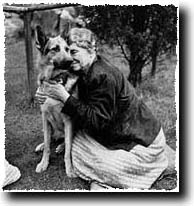 (Left:
Teacher and author Helen Keller hugs her German shepherd on a garden
lawn.)
(Left:
Teacher and author Helen Keller hugs her German shepherd on a garden
lawn.)
With the breed arriving in Britain mainly on the strength of its reputation as a war dog, its sterling qualities as a sheepdog were largely overlooked. At that time Britain already had a string of quality working sheepdogs such as Collies, Corgis, and Old English Sheepdogs. Therefore, the pattern of development of the German Shepherd in the USA, UK, and Australia was to be dictated by its adaptability. The Seeing Eye dogs in the USA and Britain were predominantly German Shepherds and only later did the Labrador challenge this position.
At the outbreak of World War II, the trained dogs of the Allied Forces were seen wherever the troops travelled, spreading the breed’s popularity like a blanket around the world.